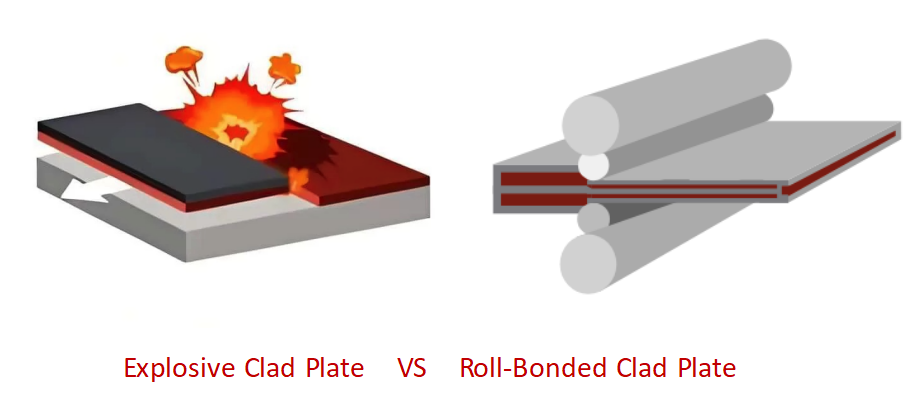

In the field of industrial materials, clad plates represent sophisticated solutions to diverse challenges across various sectors. By bonding layers of different metals, these composite materials offer unique combinations of properties. The two most common methods for producing clad plates are explosive bonding and roll bonding. Due to differences in their production processes, stainless steel explosive clad plates and hot-rolled clad plates exhibit distinct characteristics and application ranges. This article provides a comparative analysis of these two types of clad steel plates regarding their production methods, process features, and relevant standards, offering guidance for their use in different industries.

Explosive cladding is a highly specialized process that utilizes controlled detonations to bond metals. The working principle is as follows: two metal plates are positioned close to each other, and a precisely engineered explosive charge is applied. The force generated by the explosion drives the plates together at high velocity, causing the atoms at the interface to metallurgically fuse.
This method is renowned for producing very strong bonds between metals that are often difficult to weld or join using conventional techniques. It is particularly suitable for manufacturing clad plates with thick cladding layers and for joining metals with vastly different properties. Industries from aerospace to chemical processing rely on explosive clad plates for applications demanding reliability and performance under extreme conditions.
(1) Can produce clad plates from stainless steel, titanium, copper, aluminum, etc., but faces challenges with low-ductility materials like martensitic stainless steels.
(2) Capable of producing clad plates with a total thickness of several hundred millimeters, but the cladding layer thickness is typically ≥ 3 mm, and the plate area is≤ 20 m², making it unsuitable for applications requiring thin cladding over large areas.
(3) The process concept is simple but technically demanding; parameters are difficult to control precisely, production efficiency is low, and it is susceptible to weather conditions.
In contrast to explosive cladding, roll bonding is a mechanical cladding process where metal plates are passed through a pair of rollers under high pressure and often elevated temperature. This method is suitable for producing clad plates with thinner cladding layers compared to explosive cladding. By applying controlled pressure, roll bonding creates a metallurgical bond between the metal layers, ensuring uniformity and integrity of the plate.
Roll-bonded clad plates are favored for their cost-effectiveness, precise thickness control, and suitability for applications where weight reduction is important. Industries such as construction, shipbuilding, and general manufacturing often utilize roll-bonded clad plates due to their versatility and the ability to tailor material properties to specific needs.
(1) Rolled-bonding process cannot directly produce clad plates with non-ferrous metals like titanium, copper, or aluminum.
(2) Suitable for producing clad plates with thin cladding layers (≥0.5 mm), offers large plate sizes and customization, but is limited by the compression ratio, cannot produce clad plates ≥50 mm thick, and is not ideal for small batches or special shapes.
(3) Continuous production leads to high bond strength, stable quality, and the cladding layer is less susceptible to contamination from the base layer.
When selecting between explosive and roll-bonded clad plates, several factors should be considered:
a. Bond Strength: Explosive cladding typically yields higher bond strength, making it suitable for scenarios where this is critical.
b. Material Thickness: Explosive cladding is suited for thicker cladding layers, while roll bonding is better for thinner layers. Generally, the total thickness for roll-bonded plates is less than 50mm.
c. Material Compatibility: Each method may have limitations in effectively bonding different combinations of metal types.
d. Cost and Efficiency: Roll bonding is generally more economical for thinner gauges, while explosive cladding may be more suitable for thicker, high-strength requirements or round shapes products, such as tube sheets for heat exchangers.
In summary, the choice between explosive and roll-bonded clad plates depends on specific project parameters. A thorough evaluation of material compatibility, bond strength requirements, and economic factors is essential for optimal selection.
For professional advice on clad plate solutions, please contact Fugo or visit our dedicated clad plate page.



Fugo Tech is focused on the manufacturing of clad metal plate and distributes the Stainless Steel, Titanium, Nickel Alloy, Zirconium and other non-ferrous metal pipes, fittings, flanges, and fasteners.